
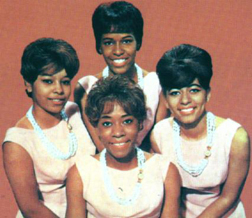
Girl Group Chronicles: The Chiffons
Arguably the definitive girl group, the Chiffons amassed an incredible catalogue of songs that showcased their versatility and their hitability in a career that has outlasted almost any other pop group of the sixties. Through ups and downs the group persevered throughout the sixties and continue to perform to this day. It is ironic that one of the best groups might have never come to prominence, had it not been for a little luck, and a lot of persistence.


Formed in the early 1960s at Monroe High School in the Bronx, New York, the three original girls, Judy Craig, Patricia Bennett, and Barbara Lee organized a group and sang for friends at lunch hour. All just 13 or 14 years of age, they gained their first record deal through a common friend, Ronald Mack.
But the group, which picked the names "the Chiffons" out of a hat, was not the first to use the moniker. A group called "the Chiffons" recorded a cover of a new Shirelles song to gain some cheap exposure. Rushed off to the small Big Deal label, the group’s version of "Tonight's The Night" b/w "Do You Know" reached number 76 on the pop charts in late 1960, although the original fared slightly better, 39 pop.
No more new releases appeared on Big Deal, but two more singles bearing the name "the Chiffons" were released in 1961 and 1962. "Never, Never b/w No More Tomorrows," in 1961 on Wildcat records sounded more like the group that would later top the charts, but the single flopped, and the result of the Reprise-released "After Last Night b/w Doctor Of Hearts" was the same despite two beautiful sides. "After Last Night" was later covered by a group called the Revlons. It is not known whether any of these early Chiffons groups were related to one another.
By late 1962, a demo tape by the Bronx-based Chiffons, now including a second lead vocalist named Sylvia Peterson (formerly of Little Jimmy and the Tops), was circulating among some New York producers. It so happened that a Mack penned ditty, "He's So Fine," caught the hear of another vocal group, the Tokens. That group, which gained celebrity from "The Lion Sleeps Tonight," began a frantic search for a label when Capitol, the company for which they had a production deal, turned down a song they knew would be a hit.
The Tokens were rejected by over 10 labels before Laurie, who was having some success with Dion and the Belmonts, decided to take a chance. "He's So Fine," with its infectious beat and 'doo-lang, doo-lang, doo-lang,' intro, suggested by a technician at the session, became an incredible success, and the girls became overnight stars. Whirlwind one-nighter tours, commercials for Great Shakes drinks and the like made the Chiffons the darlings of a nation. The song also became an international hit.
Their next single, "Lucky Me," wasn't so lucky. Although it sounded like a duplicate of their big hit, a strategy commonly used to exploit girl groups, the sparkle was clearly missing, and the song failed to chart.
The Tokens, unsure about another follow-up, opted to release a single under a pseudonym, The Four Pennies. The result was the exceptional "My Block," which despite not having name recognition, managed a respectable number 67 pop on the Laurie subsidiary Rust Records. This famous scam was recycled by several other girl groups throughout the years to varying degrees of success.
Meanwhile, still searching for a "Chiffons" single, the Tokens accepted Carole King's demo of "One Fine Day," originally recorded by Little Eva (with background vocals by the Cookies) to tie into the "fine" theme of their first hit.The song soared into the Top Five, and became a second Top 30 hit in Britain, but not without some controversy. Various accounts of whose voices appear on the track have yet to be solved. Some musical historians say the Tokens used the backing track to a vocal demo recorded by King herself, and simply put the Chiffons vocals on top. Originally Sylvia was scheduled to record the lead part with the other girls supplying the background harmonies - but a last minute change put Judy on lead over top of the background vocals she had already recorded with Patricia and Barbara. The Cookies say the single that hit was actually the demo they had recorded with Little Eva’s vocal wiped off and replaced by Judy’s lead. Whatever the real story, the Chiffons had the hit and Little Eva and the Cookies both had to settle for low placing singles releases in competition. Many years later, King recorded her own version for her Pearls album, and reached number 12 on the pop charts, bringing the song full circle.
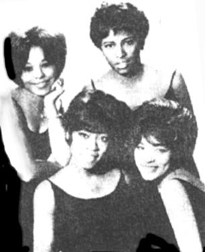
Two albums were released around this time, the first being entitled He's So Fine. It was released so quickly, the girls’ faces were cut out from pictures and taped on (something which made them quite upset), and although most of the cuts were hastily recorded covers of big hits of the day, the album became one of only a few girl group LPs to chart, at 97.
Another "fine" song was released in 1963, "A Love So Fine." While the bouncy tune rolled into number 36 pop, a single by the Four Pennies, "When The Boy's Happy (The Girl's Happy Too)," which rocked in Spectorish style, only slipped onto the charts at number 95. Thereafter, the alternate name was abandoned, save for some mysterious recordings on the Tokens’ BT Puppy label by the Penny Sisters. The Chiffons were also rumoured to be the voices behind another BT Puppy Act, the Cinnamon Angels (aka the Cinnamons).
Still another single was a hit in 1963. "I Have A Boyfriend," showcased the enthralling harmonies for which the girls were famous. Although it jumped into the Top 40, it was to be the last big hit for the Chiffons for several years.
Before the year was over the Chiffons made one more appearance on a successful album. The Angels, a girl group best known for "My Boyfriend’s Back" released a version of "He’s So Fine," on their 1963 long-player that shared the name of their hit 45. The cut, which sounded different from the other songs on the album, was actually the Chiffons’ original demo with the Angels’ voices dubbed in over top of the backing vocals. Even Judy’s lead vocal is audible under the Angels’ voices. The Angels say the stunt was pay back for a version of their big hit which they say the Chiffons released with the Angels’ voices still present. But if such a record was ever made, it was never widely released, because when the Chiffons’ finally did record "My Boyfriend’s Back" for release in 1966, the single sounded quite different and tougher than the Angels’ sweet harmonies.
After the group hit with "He's So Fine," many artists used the nonsense lyric to open their songs. Laurie Records tried to do the same thing with female vocal star Andrea Carroll. Previously known for the original version of Diane Ray’s hit "Please Don’t Talk To The Lifeguard," Carroll’s sole hit came with Neil Sedaka's "It Hurts To Be Sixteen." The Chiffons and Ellie Greenwich sang the infectious "rat-a-tang-doo-tang" backing vocals while Andrea sobbed about her life as a sixteen year old. The song bounded up the Top 100 soon afterwards, an later appeared with a new lead vocal by Judy on the group’s rare 1970 album, My Secret Love.
The Chiffons started 1964 with, "Easy To Love (Hard To Get)," a song with much of the same appeal of "He's So Fine," but it only achieved Bubbling Under status. Part of the reason might have been the song’s out-dated production sound during a time when the Beatles were taking over the music scene. The group returned to the charts later that year with "Sailor Boy," an angelic sounding recording which reached number 81. One further single, the excellent "What Am I Gonna Do With You (Hey Baby)," written by Russ Titelman failed to chart, though the girls kept a busy schedule by touring with the Rolling Stones and the Beatles during the year.
A second Andrea Carroll single, "The Doolang," was also released during 1964. Just how commercial could a song be? With the famous "doo-lang" backing by the Chiffons again used to full effect, the catchy upbeat tune about a dance craze should have been a huge hit. But once again the song was too 1963 for the public’s taste and it failed to make an impression on the charts. The Carroll/Chiffons partnership was ended soon after.
In a bold and unexpected move, the Chiffons took Bright Tunes, their recording company, to court in hopes of freeing themselves from a restrictive contract that used much of the profits from the group’s records to pay for studio costs. The group, having been minors when they first signed, won the suit and began searching for a new label. But there was a slight problem. Despite their long list of hits and tremendous popularity, no other labels wanted to touch the group for fear of further lawsuits The Chiffons returned to Laurie, signing directly with the label, but not before losing some of the momentum they had before the court case.
In an attempt to reinvent themselves and sound more current, the girl's first single of 1965 was a spectacular psychedelic piece produced by Brute Force. "Nobody Knows What's Going On (In My Mind)" charged up the single charts and headed into the Top 50. The group, sans a pregnant Judy who was replaced by a friend, lip-synced the song on Shindig and the feature film Disk-o-Tek Holiday that year. One other single "The Heavenly Place," although beautiful, was lost in the shuffle and failed to chart.
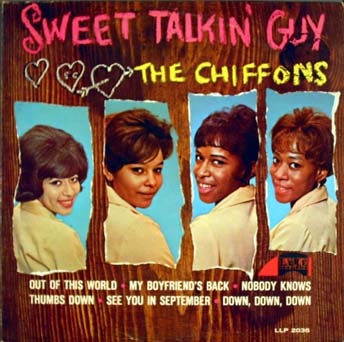
By 1966 the popular music scene was really changing. Girl groups were finding it much more difficult to compete in such a diverse market place, and groups without big name recognition, like the Supremes, were almost always doomed. The Chiffons, however, were the exception, restoring themselves to the Top 10 early in the year with "Sweet Talkin' Guy." The song, which fused the Brill Building sound with a Motown beat and some Mamas and the Papas’ styled harmonies, has since become a classic and perennial favourite of oldies radio. Most surprising was that such a sweet song could make it in a time when the music was becoming more dark and rebellious.
Laurie issued the similar sounding, yet equally pleasurable "Out Of This World," as the follow-up, but it fell short of expectations by only reaching 67. "Stop, Look, And Listen," a pounding beat record which is popular in Northern Soul circles today, looked to be a sure bet for a hit, save for the fact that an almost identical version had been released only one year earlier by another Laurie group, LES Girls. The song reached number 85. Later that year, the girls' version of "My Boyfriend's Back" limped to number 117. The song was taken by the group’s final Laurie LP, titled Sweet Talkin’ Guy. It didn’t sell a lot of copies, but the songs included showed a marked improvement from the two earlier albums which were rushed to the market.
Over the next three years, the girls were forced to record mediocre material as best they could, although some tries like "Up On The Bridge," and "Just For Tonight" were not half bad. In fact, the latter song became a number 7 smash in Toronto, Canada, but it still failed to reach the top 100 in North America. The Chiffons left Laurie following "Love Me Like You're Gonna Lose Me." The flip of that single, "Three Dips Of Ice Cream," was a try at the "bubble gum" craze, but it just wasn't the group's style. The Chiffons' usual lead vocalist, Judy Craig, decided to leave at this juncture.
"My Secret Love" and an album by the same name were put out by the Tokens' BT Puppy Records to an indifferent audience. The album, dedicated to the memory of Ronnie Mack who had died of Hodgkin's’ disease at the height of the group’s popularity in 1963, featured unreleased tracks from the group’s time at Laurie. Few copies were pressed and today the album’s a rare collector’s item. Some songs, including "Every Boy, Every Girl," "Remember Me," and the group’s take on Andrea Carroll’s "It Hurts To Be Sixteen," (for which they had supplied back-up vocals) could have been hits if released when first recorded back in 1963. In 1971 the Chiffons recorded their version of the Tymes' "So Much In Love," for Buddah Records, but it too fared poorly, and the group began playing some revival shows, waiting for their next chance to record.
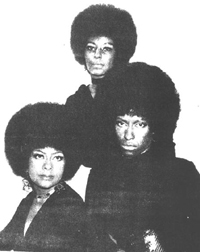
Meanwhile, two separate events would put the Chiffons' name back in the minds of the pop buying public. George Harrison, a former Beatle, released a song called "My Sweet Lord," in 1971. The Number One best seller sounded suspiciously like the Chiffon's "He's So Fine." Harrison was taken to court as the publishers of the song, and the estate of Ronald Mack, fought to receive a percentage of the profits.
In 1972, the Chiffons made a surprise return to the Top 5 when a reissue of their "Sweet Talkin' Guy," hit number 4 in the Untied Kingdom when a record exec thought the song deserved a second chance. Unfortunately the group was not signed to a major label at the time, and therefore could not promote themselves any further.
Not much more was heard from the three girls from the Bronx until the Mack versus Harrison court case was settled in favour of the Chiffons’ mentor. Although the group did not monetarily profit from the decision, they did ironically return to Laurie to cut their own version of the song. The girls' song failed to scratch the chart, but they did generate enough interest for Laurie to issue a another single. "Dream, Dream, Dream" was an old, unissued song from the group's first tenure on the label, and, as such, it had too much of an old sound for the market place.
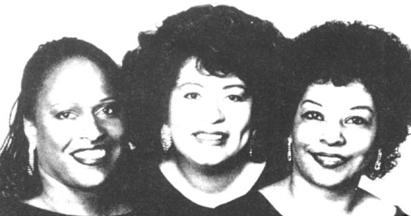
During the late seventies, the femmes fantasiques re-recorded their old hits for several budget labels, though in interviews the remaining trio said they had become wary of the recording industry. Still, Sylvia, Pat, and Barbara, occasionally joined by Judy for special performances, kept singing throughout the 1980s and early 90s. In 1994, Barbara Lee died of a heart attack and Judy returned permanently along with daughter Dawn Mann and several other alternating vocalists, including Judy’s niece. Several Greatest Hits packages brought the girls into the compact disc age and in 1997 the film "One Fine Day" and its hit soundtrack featuring the Chiffons' original cut of the title track brought renewed interest to the group and allowed a brand new generation to hear the group’s trademark harmonies. The group also has two songs in the Top 100 of Dave Marsh’s Heart of Rock And Soul: The 1001 Greatest Songs Ever Made.
The Chiffons continue to perform to this day. Recently, they were invited to perform at a PBS concert celebrating legendary girl groups along with Ronnie Spector, Martha Reeves and the Vandellas, Darlene Love, the Angels, and other. Of course, our fine ladies wowed the audience and proved they still have those golden voices that won them so many fans over the past 40 years!
Recommended Listening:
The Chiffons’ Greatest Recordings (1990) Ace Records
Video: Disk-O-Tek Holiday (1965) Features the Chiffons (minus a pregnant Judy) perfomring their hit "Nobody Knows (What’s Going On In My Mind But Me)."
Suggested Reading:
Clemente, John. Girl Groups: Fabulous Females That Rocked The World. Krause Publications: Iola, WI, (2000), pp. 52-55.
Warner, Jay. Billboard’s American Rock’n’Roll in Review. Schirmer Books: New York, (1997), pp. 40-41
Warner, Jay. The Billboard Book of American Singing Groups: A History 1940-1990. Billboard Books: New York, (1992), pp. 343-345.
